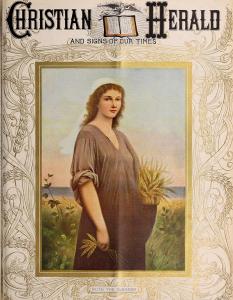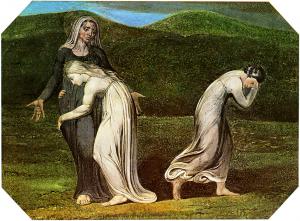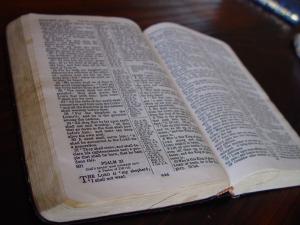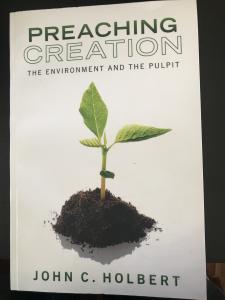 Last week I offered a reading of Ruth that has become important to me as an antidote to the overly romanticized portrait commentators have long provided. As I noted, after the fine analysis of Phyllis Trible in her groundbreaking book, God and the Rhetoric of Sexuality, simple readings of Ruth are no longer possible. Ruth is a book about a woman of power who through her fabled and risky devotion to her mother-in-law moves her world from emptiness to fullness. Thus, the tale can become a model for anyone who believes that a powerful love can indeed change the world.
Last week I offered a reading of Ruth that has become important to me as an antidote to the overly romanticized portrait commentators have long provided. As I noted, after the fine analysis of Phyllis Trible in her groundbreaking book, God and the Rhetoric of Sexuality, simple readings of Ruth are no longer possible. Ruth is a book about a woman of power who through her fabled and risky devotion to her mother-in-law moves her world from emptiness to fullness. Thus, the tale can become a model for anyone who believes that a powerful love can indeed change the world.
In this essay today I wish to explore the placement of the book of Ruth in its canonical context and imagine what that placement has to say about the ongoing potency of a comprehensive biblical faith. The book of Ruth was never questioned as a part of the Hebrew canon of scripture, but its placement within that canon was not a fixed one. In the traditional canon of the Hebrew Bible Ruth is found among the writings, the third portion of the canon, kethuvim in Hebrew. But even there its placement is not the same among the various traditions. The Babylonian Talmud places Ruth first, followed by the Psalms. This placement appears to be for two reasons. First, Ruth antedates the Psalms chronologically since it is set in the time of the judges (1:1), this predating the other writings. Second, Ruth ends with a genealogy, thus preparing for the Psalms, many of which are attributed to the second king of Israel, David. Thus, Ruth is both a very ancient text, according to this version of the Talmud, and it prepares the reader for the wonders of the Davidic psalms that follow.
Another tradition finds Ruth among the five Megilloth, or “scrolls” in Hebrew. Here the order of the five is given as: Song of Songs, Ruth, Lamentations, Qoheleth, and Esther. This, however, is surely a late order, since it follows the ordering of the major feasts of Israel at which each of the scrolls is read. Ruth is read at Pentecost (shabu’ot), the second of the yearly feasts. However, in Codex Leningradensus (1008CE), the text that underlies the common Biblia Hebraica, the Hebrew text used by most scholars, the order has Ruth first among the five, perhaps again suggesting a chronological principle governing the order. Again here Ruth is thought to reflect the time of the judges, moving toward the fifth of the scrolls, Esther, set in Persia well after the Babylonian exile of Israel, many centuries later.
The ordering of the Greek Bible, the Septuagint, brings us to the ordering that we Protestant Bible readers know where Ruth comes after Judges and before the books of Samuel. The placement appears to be most simply the belief that Ruth is set in the time of the judges and thus should be connected to that ancient book, and that the genealogy of David prepares the reader of scripture for the long story of that famous king found in the books of Samuel. Then too ancient tradition suggested that Samuel was in fact the author of Ruth, though of course there is absolutely no proof of the claim.
But this familiar placement of Ruth between Judges and Samuel raises a series of speculations about possible theological and literary meanings. The book of Judges ends with the horrifying story of the concubine, a woman abused by a priest and finally dismembered in the attempt to foment war between several Israelite tribes. The book of Judges ends with that laconic and appalling line: “In those days there was no king in Israel; every man did what was right in his own eyes” (Judges 21:25). In other words, the time of the Judges was one of chaos and random acts of violence, and a reading of the book bears that judgment out. But with the story of Ruth, set in the same historical time, we learn that not every male did what was right in his own eyes, but in fact treated women with respect. Boaz is a “man of honor,” (ish chayil), who gives Ruth the same appellation, “woman of honor” (ishah chayilah Ruth 3:11). In that way Ruth is a kind of antidote to the misogynistic horror of the tale of the murdered concubine.
Also, Ruth complements the story of Hannah at the beginning of the books of Samuel (1 Samuel 1:1-2:21). Hannah’s story is also set in the time of the judges, and suggests the theme of the providence of God. YHWH remembers Hannah and gives to her a son. Since Ruth is more to Naomi than seven sons (Ruth 4:15), the claim that Elkanah makes that he is more than ten sons to Hannah, is called into question by Ruth, whose story honors her above all males. Then too Ruth follows the Proverbs in this ordering of the Hebrew Bible, based on the Septuagint, and thus directly follows the famous poem about the “woman of honor” in Prov.31:10-31. As we saw above, this same phrase is used for Ruth (Ruth 3:11), uttered by her soon-to-be husband Boaz.
Other biblical allusions may be noted to cement Ruth in a wider biblical context. The crucial memory of Abraham’s departure from Haran, specifically leaving his father and mother, and his clan (Gen.12:1-3), is echoed quite directly again in the mouth of Boaz who announces that Ruth has also left country, clan, and family and come to a foreign place (Ruth 2:11), thus becoming in effect a new Abraham, and like that patriarch should be honored for her great risks. In addition, foreigners are numerous in the story of Israel. Ruth is compared favorably with other ancient foreigners who were crucial in the story of Israel: Rachel, Leah, and Tamar are specifically noted in Ruth 4:11-12. And, of course, the fact that Ruth is named as David’s great-grandmother establishes her, a Moabite, as a central figure in the ongoing story of the chosen people.
Nor should one forget the clear mention of Ruth standing in the genealogical line of Jesus as recorded by Matthew’s gospel (Matt. 1:3-6). She is among five women mentioned in that line, a startling fact given that genealogies often avoid women altogether; note Luke’s genealogy at 3:31-33 that names only men while consigning the name of Ruth to oblivion.
In these many ways, among others, Ruth may become more than an exemplar of unbreakable devotion within the bounds of her own story. She can be said to comment, to complement, to add to the long story of Israel in several important ways. Reading the Bible in its broad context can yield insights worthy of reflection and comment, both in study and in the pulpit. I trust these few ideas have energized you to take with more seriousness just how the Bible interacts with itself to deepen and broaden its wonders for the modern reader.
(Images from Wikimedia Commons)











